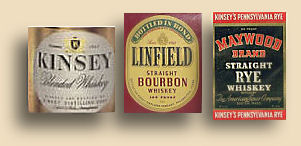American Whiskey
Distilleries of Eastern
Pennsylvania
June 16, 2006 |
|
UNIVERSITY ROWING TEAMS tend to prefer straight rivers. Wide,
smooth, straight rivers, with plenty of room to maneuver their long racing
sculls.
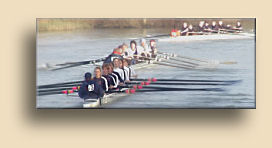 The
Schuylkill River suits that need perfectly as it passes the beautiful old racing
club boathouses as it runs along the western side of
Philadelphia, but on its way there from the factory outlets out in Reading it's
a lot more, well, interesting. It twists. It turns. It changes directions
radically, and often. In some places it almost threatens to cut itself off and
disappear into an endless circle. One place where that happens is the site of
the old Kinsey Distillery, near the village of Linfield, Pennsylvania, and less
than eight miles from where we once lived.
The
Schuylkill River suits that need perfectly as it passes the beautiful old racing
club boathouses as it runs along the western side of
Philadelphia, but on its way there from the factory outlets out in Reading it's
a lot more, well, interesting. It twists. It turns. It changes directions
radically, and often. In some places it almost threatens to cut itself off and
disappear into an endless circle. One place where that happens is the site of
the old Kinsey Distillery, near the village of Linfield, Pennsylvania, and less
than eight miles from where we once lived.
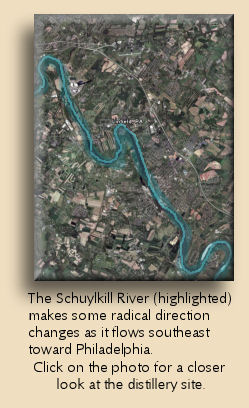 We learned about the Kinsey
distillery while exploring the story of the giant Publicker Industries Corporation, a story nearly as twisty
and full of switchbacks as the
Schuylkill River itself. The Kinsey Distillery was operated by the Continental
Distilling Corporation beginning shortly after the end of prohibition up until the
mid-1980s. Continental was a subsidiary of Publicker.
We learned about the Kinsey
distillery while exploring the story of the giant Publicker Industries Corporation, a story nearly as twisty
and full of switchbacks as the
Schuylkill River itself. The Kinsey Distillery was operated by the Continental
Distilling Corporation beginning shortly after the end of prohibition up until the
mid-1980s. Continental was a subsidiary of Publicker.
Continental called the site the Kinsey Distillery. Apparently no one else did.
Nearly all the other sources we've found, including official documents as well
as general usage, refer to the site as the Linfield Distillery or the Linfield
Industrial Park, although they acknowledge
Continental's propriety. When we called the real estate company that handles it
for permission to photograph the site, John asked if it was the old Kinsey
Distillery, and the agent said right away that it was.
People also tend to assume that Continental distilled
whiskey here.
And they may have.
Perhaps.
Except...
Except that Continental's main plant was located in Philadelphia. Their own
promotional literature boasts eloquently of their modern technological approach
to making whiskey, and the efficiency of their state-of-the-art facility. 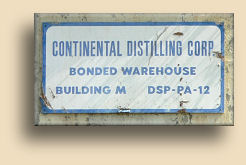 The
same literature also describes, and with equal pride, their distillery
here on the banks
of the Schuylkill River, with modern warehouses to store "the world's largest
single concentration of aging whiskies". The literature, however, carefully
avoids mentioning anything about actually distilling any of
that whiskey at the Kinsey site. A
few relics of barrels remain in the
warehouses, and the barrelheads indicate they were filled, not at DSP-PA-12,
which was the Kinsey site's official designation, but at DSP-PA-1, which was
Continental's Philadelphia plant.
The
same literature also describes, and with equal pride, their distillery
here on the banks
of the Schuylkill River, with modern warehouses to store "the world's largest
single concentration of aging whiskies". The literature, however, carefully
avoids mentioning anything about actually distilling any of
that whiskey at the Kinsey site. A
few relics of barrels remain in the
warehouses, and the barrelheads indicate they were filled, not at DSP-PA-12,
which was the Kinsey site's official designation, but at DSP-PA-1, which was
Continental's Philadelphia plant.
We saw no barrels marked with the DSP-PA-12 location.
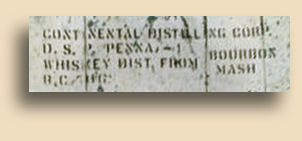
In the Publicker Industries promotional material they treat their Continental
Distilling Corporation and their Kinsey Distillery as two separate entities. So
they may, indeed, have distilled whiskey at Linfield and not just used the site
as a warehousing facility. Perhaps that was before or after the promotional
booklet was produced.
The publication doesn't refer to this site as the "Linfield Distillery".
In fact, it isn't very specific about just where their Kinsey Distillery was
located. Continental did market a Linfield brand of whiskey, a bottled-in-bond straight
bourbon, whose label states it was "Bottled for the Kinsey Distillers Company,
Philadelphia, Penna.", but that brand isn't listed among their spotlighted
brands in the early promotional brochure. And there was the Kinsey brand itself;
but that was a blended whiskey which would more likely have been produced at the
Philadelphia location and which required no aging beyond that required of the
component ingredients. Interestingly, a secondary label on the
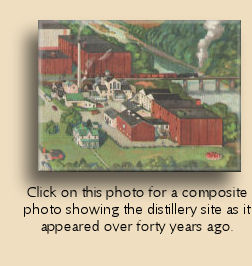 Kinsey bottle
purports to be an assurance of fine quality and "a half century" of personal
supervision, over the signature of J. G. Kinsey, himself. Not an insignificant
feat for a gentleman who would have been in his late seventies in 1933 when the
Continental Distilling Corporation was formed.
Kinsey bottle
purports to be an assurance of fine quality and "a half century" of personal
supervision, over the signature of J. G. Kinsey, himself. Not an insignificant
feat for a gentleman who would have been in his late seventies in 1933 when the
Continental Distilling Corporation was formed.
For, according to Ellwood Roberts' biographical research on his own family,
which he published in 1904, one Jacob G. Kinsey was born in Lower Salford,
Pennsylvania on March 13, 1858, As a young man Jacob went into the creamery
business and by his early thirties he owned three creameries. In 1891 he sold
them and built a distillery and 2,000 barrel capacity warehouse in Linfield. He
later increased the capacity to 20,000 barrels, and was still successfully
engaged in that business as of 1904.
It would not be difficult to imagine that
Jake called his whiskey "Kinsey's".
But then, what about Angelo?
Angelo? Who's Angelo??
We first became acquainted with Angelo (and the Kinsey brand) by way of a picture we were sent by a
reader. It's
apparently a painting that was made as an advertisement for Kinsey's whiskey brand.
That was a popular promotional tool in the 19th and early 20th centuries. Large
prints of such
paintings would be made available to saloons and liquor retailers, or it may
have been printed on serving trays and distributed as giveaways. This particular picture is
of an idyllic hunting scene.
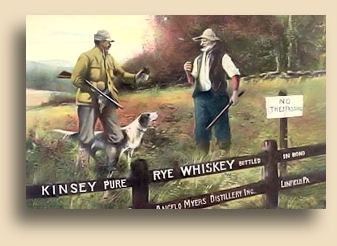 Well, perhaps it didn't start out so idyllic after
all. We see there is a hunter (of course), dressed in hunting clothes and accompanied
by a hunting dog. He is a successful hunter, and carries a bird in one hand
while balancing his hunting shotgun in the crook of his elbow. That's because in
his other hand he is holding a flask, from
which he has just poured a drink for the other gentleman in the picture.
Well, perhaps it didn't start out so idyllic after
all. We see there is a hunter (of course), dressed in hunting clothes and accompanied
by a hunting dog. He is a successful hunter, and carries a bird in one hand
while balancing his hunting shotgun in the crook of his elbow. That's because in
his other hand he is holding a flask, from
which he has just poured a drink for the other gentleman in the picture.
The other gentleman is not a hunter, though; We can see that, because he isn't wearing hunter's garb. He appears to be the farmer who owns this land.
There is a large "No
Trespassing" sign.
The farmer is carrying something that might also be a shotgun, or a large, heavy
stick.
And he's holding it in a somewhat more threatening way.
The artistry of this painting is evident in the subtle expression on the farmer's face, indicating that the whiskey is (1) strong, (2) good, and (3) cause enough to forgive this stranger his trespasses and wish him good hunting.
Thus, it appears these gentlemen have just reached a temporary
land-use arrangement that suits them both better than the farmer had expected
when he went out to have a word with the hunter. And the writing on the fence in
the foreground make it clear that sharing fine Kinsey Pure Rye Whiskey (bottled
in bond) has been a contributing factor to the resolution of this situation.
What a great advertisement!
A terrific sentiment, and how very, very true!
And then there's the second rail of the fence, with it's own message.
"Angelo Myers Distillery, Inc. -- Linfield, PA."
I'll bet you already know this, don't you? Of course there really was an Angelo Myers
Distillery. Or more accurately, the A. & H. Myers Distilling Company, Inc.,
Angelo J. Myers, President. The Philadelphia-based company was a major whiskey
wholesaler from 1874 to 1918, with branch offices in several U. S. cities.
Or more accurately, the A. & H. Myers Distilling Company, Inc.,
Angelo J. Myers, President. The Philadelphia-based company was a major whiskey
wholesaler from 1874 to 1918, with branch offices in several U. S. cities.
The firm is included in Philadelphia's 1886 List of Leading Merchants and Manufacturers. At that time the only brand mentioned was Schuylkill.
They appear in the 1910 and 1915 Philadelphia city directories, too, nearly a quarter century later. During those years they'd developed or acquired several other brands of whiskey. And what brands of liquor did A. & H. Myers market? Well, Myers Pure Malt shouldn't be too surprising. Nor, considering its Philadelphia location, would be Independence Hall, Neshaminy Rye, Oglethorpe Club, or Old Schuylkill Choice Rye.
But wait, there's more! What do we have here? How about Kinsey and Kinsey Special ?
So, it appears that some time after Roberts' biography of 1904 was published and
before the 1910 city directory listings, there may have been an arrangement
between them involving the
distillery in Linfield.
Of course, there were a few other things going on that affected the distilling
industry then, as well.
 For example, the Pure Food &
Drug Act of 1906-09 sent many an otherwise fine brand of liquor into never-never
land. Kinsey's Pure Rye - Bottled in Bond was probably not a
victim of that legislation; the Bottled-in-Bond act, with its even tighter
restrictions, had been in effect since 1879. But we notice that when the
Kinsey's brand re-started after prohibition it was as a blended whiskey and not
subject to bottled-in-bond restrictions (such as being a straight whiskey and
distilled at a particular location). But it would not be too imaginative to
suspect some of Myers' other offerings -- particularly their more profitable
ones -- may have been compromised.
For example, the Pure Food &
Drug Act of 1906-09 sent many an otherwise fine brand of liquor into never-never
land. Kinsey's Pure Rye - Bottled in Bond was probably not a
victim of that legislation; the Bottled-in-Bond act, with its even tighter
restrictions, had been in effect since 1879. But we notice that when the
Kinsey's brand re-started after prohibition it was as a blended whiskey and not
subject to bottled-in-bond restrictions (such as being a straight whiskey and
distilled at a particular location). But it would not be too imaginative to
suspect some of Myers' other offerings -- particularly their more profitable
ones -- may have been compromised.
In addition, by the mid-teens production restrictions in support of World War I materiel needs polished off many of those distilleries that remained. Especially the small ones.
And then there was also the growing public temperance and
anti-saloon sentiment, and the spectre of national prohibition looming overhead.
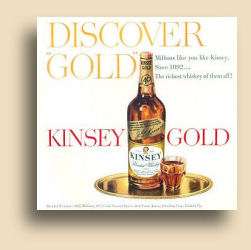 We tend to think of Prohibition as "The Great Experiment", a term popular with
those who opposed it. It's easy to lose sight of the fact that the impact of the
18th Amendment was not a fourteen-year
moratorium; it was the total and irrevocable elimination of all alcohol
beverages in America. From sea to shining sea. Forever. One could hardly
fault an astute Philadelphia liquor merchant in 1918 for taking the opportunity to sell off his stock and
get out while still profitable.
We tend to think of Prohibition as "The Great Experiment", a term popular with
those who opposed it. It's easy to lose sight of the fact that the impact of the
18th Amendment was not a fourteen-year
moratorium; it was the total and irrevocable elimination of all alcohol
beverages in America. From sea to shining sea. Forever. One could hardly
fault an astute Philadelphia liquor merchant in 1918 for taking the opportunity to sell off his stock and
get out while still profitable.
So, did Angelo take off with all the profits, change his name, and move to
Bolivia?
Did Jake cool his heels until fourteen years later when he could sell the old
distillery to Publicker and retire on a nice salary for doing little more than
licensing his name to be used on blended whiskey?
We leave that for you, dear reader, to figure out.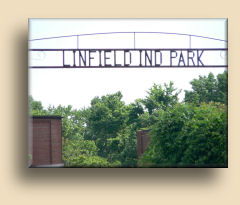 But this is exactly why Linda and John so love this obsession we have with
America's whiskey.
But this is exactly why Linda and John so love this obsession we have with
America's whiskey.
So, is there anything left of this interesting distillery, an important part of Linfield, Pennsylvania's economic base for nearly a hundred years? Is there anyone who even remembers that such a distillery ever existed, as recently as thirty or so years ago? We often find that the second question brings only a puzzled expression, followed by something along the lines of, "Well... I wouldn't know 'bout no distillery being 'round here. Mighta been, though. We're not drinkers, you know."
But Linfield isn't like that. People in Linfield accept the abandoned Continental or Linfield distillery as a local landmark, and every once in a while there's discussion of what can be done with it. You can find references to it on Montgomery County's web pages. The site was known as Linfield Industrial Park for awhile, but no other industries ever moved into it.
Photos of the distillery have also been featured on several private websites. Art photographers love the post-holocaust, abandoned, crumbling, weed-covered buildings look. And they all seem to be especially fond of the fact that you can incorporate the (very) nearby Limerick New-Color plant into the background. Really intensifies that "morning after Three-Mile-Island" image; know whattamean, Vern? Many of these pages contain truly awesome work -- do an internet search on "linfield industrial"; select "images" if you use Google (bottom of this page has a link). The photos you see here that we took are more informational and "souvenir-ish" than artistic.
Dave Ziegler: Kinsey Worker Extraordinaire
Back in 1966, a young man just out of high school, and not
yet old enough to even touch whiskey, got a job working with the maintenance
crew at the Kinsey distillery. Well, all right, it wasn't really a "distillery"
anymore; mostly it was a storage facility and bottling plant for Continental.
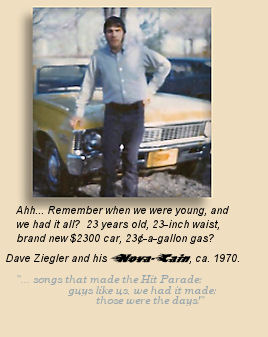 But his job brought him into daily contact with all the old distillery buildings
and equipment as well as the current storage warehouses and bottling lines.
Kinsey was a HUGE storage site; it was also the largest bottling facility on the
planet in its day. It
also brought him into daily contact with people who made the plant a living,
breathing organism and not just a "liquor factory". These people never spoke of
"Linfield", only "Kinsey", and their lives and memories provided an unbroken
line connecting all the way back to its glory days.
But his job brought him into daily contact with all the old distillery buildings
and equipment as well as the current storage warehouses and bottling lines.
Kinsey was a HUGE storage site; it was also the largest bottling facility on the
planet in its day. It
also brought him into daily contact with people who made the plant a living,
breathing organism and not just a "liquor factory". These people never spoke of
"Linfield", only "Kinsey", and their lives and memories provided an unbroken
line connecting all the way back to its glory days.
Dave Ziegler grew up working for Publicker/Continental at Kinsey. He worked there for many years; he says they were the best years of his life. The distillery itself had gone dark long before, back in 1951 (when Dave's father was working there). The bottling line shut down for the last time in 1979, although Kinsey continued to serve as a warehouse site until 1986.
Dave might not have been the last guy out; he was probably not the one who switched
off the lights as he left. But for several years now he's been collecting those
lights, and switches, and papers, barrelheads, advertising promos,
explosion-proof telephones, and historical knowledge.
 A one-man treasure chest
of information about the Kinsey distillery, Dave is fearless in his quest to
salvage and preserve as much as possible before the wreckers, the vandals, and
even Mother Earth herself dissolves it all back into the Pennsylvania
countryside from whence it sprang. Armed with camera and flashlights (and
snakebite kit), he has collected the most comprehensive set of photographs
imaginable of a facility that has laid derelict for decades, entering alone into
pitch-black and dangerously insecure caverns where one false step would
certainly leave him without any hope of rescue or even discovery. Under
the screen name "kinseyworker", he has posted many of his photos, along with those
of a portion of his memorabelia collection, on the Bourbon Enthusiast bulletin
board forum. His work is extensive, and provides probably the best understanding
available anywhere of the American whiskey industry as it really was until just
day-before-yesterday. Dave is a gregarious sort today, and there's no reason to
think he was any less so thirty years ago. He has an insatiable thirst for lore
and stories and the things that people bring to and take from where they work.
Years later, those wonderful stories are a big part of Dave's memories, and of
his conversations. The details of his stories bring the listener right into the
picture, as though you were actually sharing with him your own memories of being
a young man and of working there -- even though you weren't. You should visit his
"My Days at Kinsey Distillery" topic
at
http://bourbonenthusiast.com/forum/viewtopic.php?f=17&t=4923
A one-man treasure chest
of information about the Kinsey distillery, Dave is fearless in his quest to
salvage and preserve as much as possible before the wreckers, the vandals, and
even Mother Earth herself dissolves it all back into the Pennsylvania
countryside from whence it sprang. Armed with camera and flashlights (and
snakebite kit), he has collected the most comprehensive set of photographs
imaginable of a facility that has laid derelict for decades, entering alone into
pitch-black and dangerously insecure caverns where one false step would
certainly leave him without any hope of rescue or even discovery. Under
the screen name "kinseyworker", he has posted many of his photos, along with those
of a portion of his memorabelia collection, on the Bourbon Enthusiast bulletin
board forum. His work is extensive, and provides probably the best understanding
available anywhere of the American whiskey industry as it really was until just
day-before-yesterday. Dave is a gregarious sort today, and there's no reason to
think he was any less so thirty years ago. He has an insatiable thirst for lore
and stories and the things that people bring to and take from where they work.
Years later, those wonderful stories are a big part of Dave's memories, and of
his conversations. The details of his stories bring the listener right into the
picture, as though you were actually sharing with him your own memories of being
a young man and of working there -- even though you weren't. You should visit his
"My Days at Kinsey Distillery" topic
at
http://bourbonenthusiast.com/forum/viewtopic.php?f=17&t=4923
And now (as of 2015) the Kinsey brand has been
resurrected in style, and is once again available and being made in Philadelphia
See our page on the Millstone Spirits Group and the
New Liberty distillery!
The following are thumbnail
links. Click any of them to see larger pictures.
 |
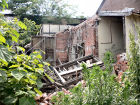 |
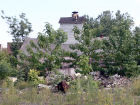 |
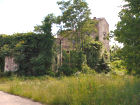 |
 |
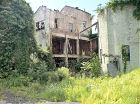 |
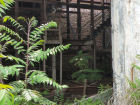 |
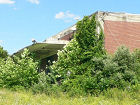 |
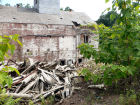 |
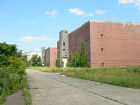 |
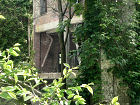 |
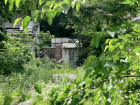 |
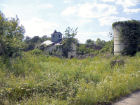 |
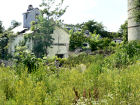 |
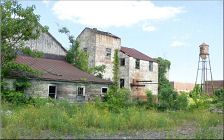 |
|
